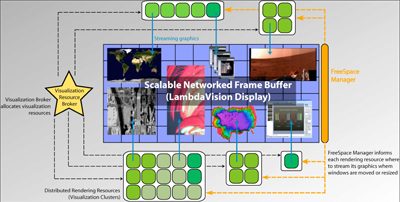Multiapplication Intertile Synchronization on Ultra-High-Resolution Display Walls
February 22nd, 2010
Categories: Networking, Software, Supercomputing, Visualization

Authors
Nam, S., Deshpande, S., Vishwanath, V., Jeong, B., Renambot, L., Leigh, J.About
Ultra-high-resolution tiled-display walls are typically driven by a cluster of computers. Each computer may drive one or more displays. Synchronization between the computers is necessary to ensure that animated imagery displayed on the wall appears seamless. Most tiled-display middleware systems are designed around the assumption that only a single application instance is running in the tiled display at a time. Therefore synchronization can be achieved with a simple solution such as a networked barrier. When a tiled display has to support multiple applications at the same time, however, the simple networked barrier approach does not scale. In this paper we propose and experimentally validate two synchronization algorithms to achieve low-latency, intertile synchronization for multiple applications with independently varying frame rates. The two phase algorithm is more generally applicable to various high resolution tiled display systems. The one-phase algorithm provides superior results but requires support for the Network Time Protocol and is more CPU-intensive.
Keywords: Frame synchronization, Tiled display, Cluster computing
General Terms: Algorithms, Performance
Resources
Citation
Nam, S., Deshpande, S., Vishwanath, V., Jeong, B., Renambot, L., Leigh, J., Multiapplication Intertile Synchronization on Ultra-High-Resolution Display Walls, To be published in the proceedings of ACM Multimedia Systems 2010, Scottsdale, Arizona USA, ACM, February 22nd, 2010.